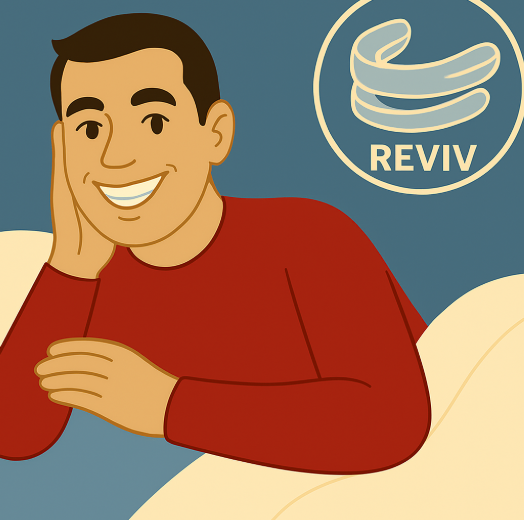
Are There Non-Surgical Options for TMJ Treatment?
Share
This article breaks down the most effective methods I’ve seen and personally tested, from self-care to innovative therapies, so you can make an informed choice before committing to anything permanent.
Self-Care Remedies for TMJ Pain Relief
I’ve learned that small, consistent changes often beat expensive interventions.
Simple adjustments to daily habits can significantly reduce TMJ pain.
Here’s what’s worked for me and others:
-
Avoid extreme jaw movements – yawning wide, chewing tough foods, or grinding teeth.
-
Practice gentle jaw exercises – short, repeated sessions throughout the day.
-
Maintain a relaxed resting jaw position – teeth slightly apart, tongue resting on the roof of the mouth.
For a step-by-step home care guide, see our blog post: Best Home Remedies and Exercises for TMJ Pain Relief.
Heat, Ice, and Massage: Which Is Best for TMJ?
If you’re wondering whether to use heat or ice, the truth is both can help—just at different times.
-
Ice is best for acute flare-ups to reduce inflammation.
-
Heat is better for chronic stiffness, relaxing tight muscles.
-
Massage—especially on the masseter and temporalis muscles—can provide almost instant relief.
I’ve found alternating heat and massage at night keeps my jaw looser by morning.
For deeper techniques, check out: Massage Therapy for TMJ Pain Relief.
Physical Therapy Methods Proven to Help TMJ
A skilled physical therapist can change the game for TMJ sufferers.
They’ll teach you jaw mobilization, stretching, and posture corrections tailored to your anatomy.
In my case, learning to release neck tension dramatically reduced jaw pain—something I didn’t expect.
The Role of Mouthguards and Splints
A custom TMJ mouthguard can stop grinding and reposition your jaw.
But not all are created equal.
Cheap store-bought guards might worsen symptoms by misaligning the bite.
The Best Mouthguard for TMJ Pain: A Buyer’s Guide explains what to look for and why brands like Reviv Mouthguard are worth considering.
Acupuncture and Osteopathy for TMJ Management
Acupuncture surprised me—it reduced my pain intensity by half after just three sessions.
Osteopathy, on the other hand, helped improve jaw movement through gentle manipulations.
Both approaches work best as part of a multi-modal TMJ treatment plan rather than stand-alone treatments.
Stress Management and TMJ Symptom Reduction
If you’re stressed, your jaw will tell you before your brain does.
Meditation, deep breathing, and even short breaks during work can lower clenching habits.
I use the “drop the jaw” technique—consciously letting my jaw hang loose when I catch myself tensing.
For more on this, read TMJ vs Stress: How to Tell the Difference & What Works.
Dietary Adjustments for Reduced TMJ Pain
What you eat matters.
Soft, anti-inflammatory foods reduce strain and swelling.
Good options:
-
Salmon and omega-rich fish
-
Leafy greens
-
Smoothies with magnesium-rich spinach or bananas
Avoid:
-
Chewy bagels
-
Tough meats
-
Crunchy snacks like almonds
Check out The TMJ Diet for a full food list.
Supplement Protocols for Jaw Health (Magnesium, Omega-3s)
Magnesium helps relax muscles.
Omega-3s fight inflammation.
Some people add collagen or turmeric for joint support.
Always start with one supplement at a time to track its effect.
For more, see What Supplements Help with Jaw Tension and Stress?.
Cognitive Behavioral Therapy for Chronic TMJ Symptoms
CBT isn’t just for anxiety—it can rewire how you respond to jaw pain.
Breaking the cycle of fear, tension, and pain can improve long-term outcomes.
Exercise and Posture Correction for TMJ Disorders
Forward head posture kills jaw alignment.
Daily neck and shoulder stretches can ease strain.
Tip:
Set a timer to check posture every 30 minutes during computer work.
See TMJ Posture and Whole-Body Alignment: What’s the Connection?.
Patient Experiences With Non-Surgical TMJ Treatments
I’ve met people who avoided surgery entirely with a mix of mouthguards, posture work, and supplements.
Most said it took 6–12 months of consistency—not overnight results.
When Is Surgery the Only Option?
If joint degeneration is advanced or conservative measures fail after a year, surgery might be necessary.
But most people never reach that point.
Read Best Non-Invasive Alternatives to Jaw Surgery for Chronic Pain before making the decision.
Advantages and Disadvantages of Non-Surgical Methods
Pros:
-
Lower risk
-
Lower cost
-
Reversible
Cons:
-
Requires discipline
-
Slower results
Combining Therapies for Enhanced TMJ Relief
The best results I’ve seen come from combining at least three approaches:
-
Mouthguard
-
Physical therapy
-
Stress management or CBT
Latest Innovations in Non-Surgical TMJ Care
Laser therapy and regenerative injections (like PRP) are gaining traction.
Some dentists are even using AI-guided bite analysis to design custom splints.
See Innovations in TMJ Therapy: What’s New in 2025 for emerging treatments.
FAQs
1. Can TMJ heal without surgery?
Yes—most cases improve with non-surgical care.
2. How long before I see results?
Anywhere from weeks to months depending on consistency.
3. Are mouthguards effective?
Yes, if custom-fitted and worn consistently.
4. Does stress cause TMJ?
It can trigger or worsen symptoms.
5. What foods help TMJ?
Soft, anti-inflammatory options like salmon, leafy greens, and smoothies.
6. Can posture affect TMJ?
Absolutely—forward head posture is a major factor.
7. Is acupuncture proven for TMJ?
Evidence is growing but results vary per individual.
8. Do supplements work?
Many help, but choose quality and track results.
9. Should I avoid chewing gum?
Yes, it strains the joint.
10. When should I consider surgery?
Only if all conservative methods fail after extended use.
Conclusion
Non-surgical options for TMJ treatment are not just possible—they’re often the smartest first step.
From mouthguards to posture correction, the right combination can bring lasting relief without the risks of surgery.
If you’re ready to start your non-surgical TMJ journey, I highly recommend trying the Reviv Mouthguard—you can get it Here.
